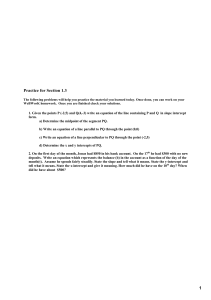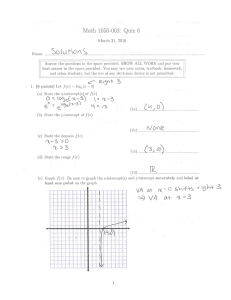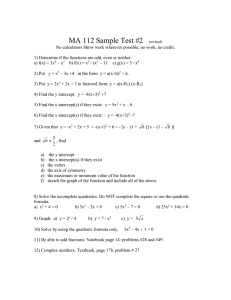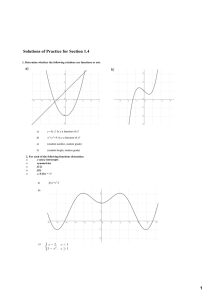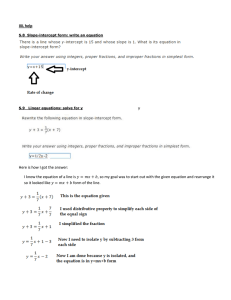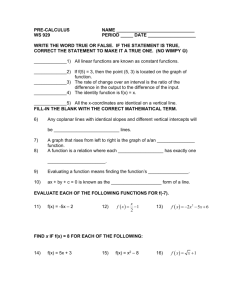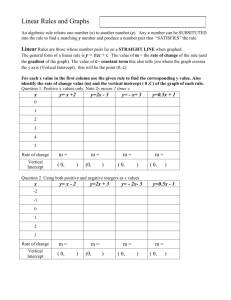The Economic Consequences of Dollar Appreciation for US Manufacturing Investment:
advertisement
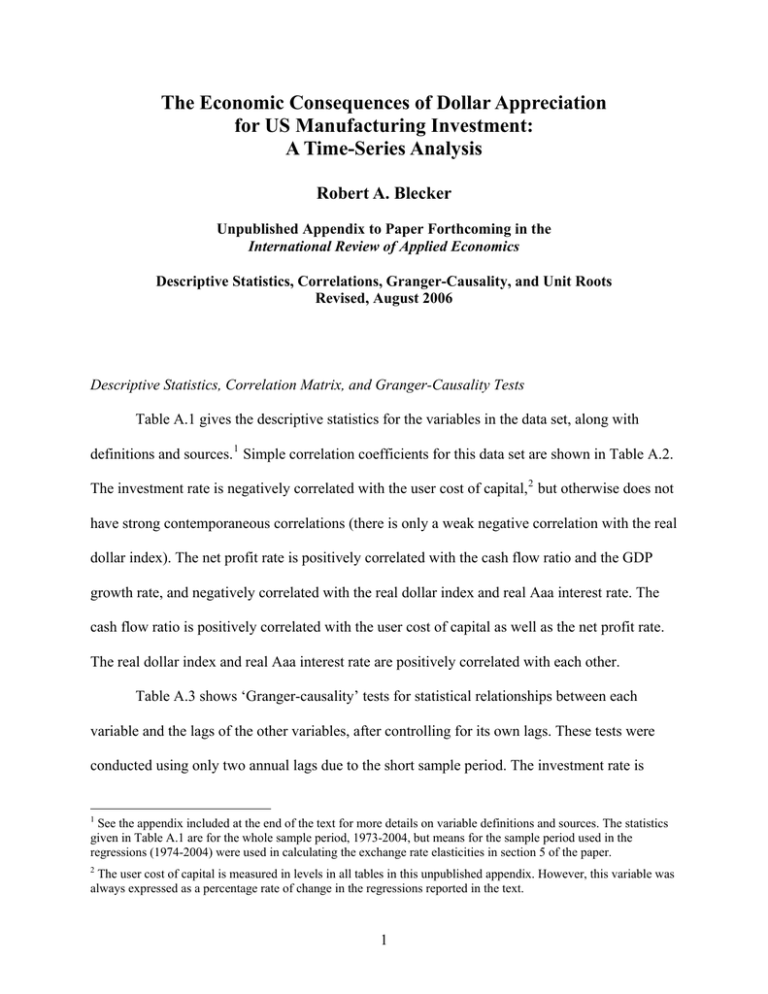
The Economic Consequences of Dollar Appreciation for US Manufacturing Investment: A Time-Series Analysis Robert A. Blecker Unpublished Appendix to Paper Forthcoming in the International Review of Applied Economics Descriptive Statistics, Correlations, Granger-Causality, and Unit Roots Revised, August 2006 Descriptive Statistics, Correlation Matrix, and Granger-Causality Tests Table A.1 gives the descriptive statistics for the variables in the data set, along with definitions and sources. 1 Simple correlation coefficients for this data set are shown in Table A.2. The investment rate is negatively correlated with the user cost of capital, 2 but otherwise does not have strong contemporaneous correlations (there is only a weak negative correlation with the real dollar index). The net profit rate is positively correlated with the cash flow ratio and the GDP growth rate, and negatively correlated with the real dollar index and real Aaa interest rate. The cash flow ratio is positively correlated with the user cost of capital as well as the net profit rate. The real dollar index and real Aaa interest rate are positively correlated with each other. Table A.3 shows ‘Granger-causality’ tests for statistical relationships between each variable and the lags of the other variables, after controlling for its own lags. These tests were conducted using only two annual lags due to the short sample period. The investment rate is 1 See the appendix included at the end of the text for more details on variable definitions and sources. The statistics given in Table A.1 are for the whole sample period, 1973-2004, but means for the sample period used in the regressions (1974-2004) were used in calculating the exchange rate elasticities in section 5 of the paper. 2 The user cost of capital is measured in levels in all tables in this unpublished appendix. However, this variable was always expressed as a percentage rate of change in the regressions reported in the text. 1 Granger-caused (at least at the 10% significance level) by the net profit rate, GDP growth rate, and user cost of capital, but not by the cash flow ratio, real dollar index, or real Aaa interest rate. 3 The net profit rate is Granger-caused (at the 10% level) only by the real dollar index, while the cash flow ratio is Granger-caused by the net profit rate and GDP growth rate. Also, the real Aaa interest rate is Granger-caused (at least at the 5% level) by the cash flow ratio and GDP growth rate. 4 The user cost of capital is Granger-caused by the net profit rate at the 10% level and by the real Aaa interest rate at the 1% level (although it should be recalled from equation (4) in the text that the contemporaneous real Aaa interest rate is part of the user cost by definition). Importantly, the null hypothesis of no Granger causality is always accepted for two key variables that we wish to treat as exogenous: the GDP growth rate and real dollar index are not significantly Granger-caused by any variables in the data set. Unit Root Tests Results of conventional augmented Dickey-Fuller (ADF) tests are shown in Table A.4. Lag length was selected by the Akaike and Schwartz Information Criteria (AIC and SIC, respectively). Each variable was tested first using only an intercept, and was retested with a trend and intercept only if it was found to have a unit root without a trend. Variables which had a unit root with a trend and intercept were also tested in first differences (except for user cost of capital, which was tested in percentage changes for consistency with how it is expressed in the 3 Note that the real interest rate is measured here in levels, while in the regressions reported in the text it is measured in first differences. 4 This could be caused by upward pressure of greater corporate borrowing on long-term corporate bond rates during boom periods, or by endogenous policy responses of the Fed (raising interest rates during a cyclical upswing), or possibly by inflationary consequences of higher growth and investment (which could reduce the real interest rate if the nominal interest rate does not adjust). 2 investment function). The null hypothesis in the ADF test is a unit root, i.e. integrated of order one or I(1). The ADF test is known to have low power to reject the null hypothesis of a unit root in relatively short time series, such as those used here (32 years of annual data). Therefore, we also used the alternative test due to Kwiatkowski et al. (1992), in which the null hypothesis is that the variable is stationary or I(0). The results of these tests (shown in Table A.5) show that the null hypothesis of stationarity is accepted at the 1% and 5% significance levels for all variables used in the regressions (including the percentage change in user cost, although not user cost in levels), although results at the 10% significance level vary for some series depending on whether a trend is included and whether the variables are expressed in levels or differences. 3 Table A.1. Detailed variable definitions and descriptive statistics Variable Definition Investment rate Gross investment as a percentage of the net capital stock at end of previous year Units Source(s) a Percent BEA b Percent BEA Percent Percent BEA BEA March 1973 = 100 FRB Percent Percent FRB and BEA BEA, FRB, ERP, and author's calculations Net profit rate Net corporate profits as a percentage of net capital stock at end of previous year Cash flow ratio GDP growth rate Corporate cash flow as a percentage of net capital stock at end of previous year b,c Growth rate of real gross domestic product in chained 2000 dollars Real dollar index Broad, trade weighted index of the real value of the dollar Real Aaa interest rate User cost of capital d e Real Moody's Aaa corporate bond interest rate See equation (4) in text for definition. Descriptive Statistics (sample period 1973-2004, 32 observations) Mean Median Maximum Minimum Std. Dev. Skewness Kurtosis Jarque-Bera Probability Sum Sum Sq. Dev. Investment rate 9.133623 8.842798 12.13372 6.588945 1.477959 0.656756 2.579703 2.535949 0.281401 292.2759 67.71527 Net profit rate 10.89318 10.51915 18.08795 3.084476 3.942217 0.098161 2.550951 0.32025 0.852037 348.5816 481.7734 Cash flow ratio 16.46032 16.33729 22.17846 11.20308 2.661196 -0.050602 2.483479 0.369381 0.831361 526.7302 219.5409 GDP growth rate 3.08125 3.5 7.2 -1.9 2.050718 -0.598515 2.998881 1.910507 0.384715 98.6 130.3688 Real dollar index 97.82802 94.89875 122.0475 86.565 9.368224 0.844619 2.881213 3.823518 0.14782 3130.497 2720.672 Real Aaa interest rate 4.707187 5.42 8.91 -0.67 2.381049 -0.513238 2.795043 1.460879 0.481697 150.63 175.7512 User cost of capital 16.68114 16.35256 22.51633 12.478 2.496182 0.288537 2.421724 0.88989 0.640859 533.7965 193.1587 Notes: BEA refers to U.S. Department of Commerce, Bureau of Economic Analysis, www.bea.gov; ERP is the Economic Report of the President 2006 , statistical tables, www.gpoaccess.gov/eop/download.html; FRB stands for Federal Reserve Board, www.federalreserve.gov/releases/. a Both investment and capital stock are measured in chained 2000 dollars, using chained real quantity indices linked to the current-dollar values for 2000; from historical data for 1947-2004 on a North American Industrial Classification (NAICS) basis (released 15 March 2006). b Net profits and cash flow are measured in current dollars; capital stock is measured at current (i.e. replacement) cost. Both the net profit rate and cash flow ratio were spliced at 1999 using Standard Industrial Classification (SIC)-based data for earlier years and NAICS-based data for 2000-2004 (data for years prior to 1998 were not available on a NAICS basis, and 1998-1999 changes were needed for splicing). c Cash flow is defined as undistributed corporate profits plus corporate capital consumption allowances (depreciation of capital stock). d e Price-adjusted and trade weighted, including both 'major' currencies and 'other important trading partners' currencies. Real interest rate calculated by subtracting the percentage change in the GDP chain-type price index from the nominal Aaa corporate bond rate. Table A.2. Correlation matrix (sample period 1973-2004, 32 observations) Investment rate Net profit rate Investment rate 1.00 Net profit rate 0.02 1.00 Cash flow ratio -0.09 0.84 GDP growth rate 0.04 0.31 Real dollar index -0.14 -0.52 Real Aaa interest rate -0.05 -0.55 User cost of capital -0.60 0.28 Note: See Table 1A for variable definitions and sources. Cash flow ratio GDP growth rate Real dollar index Real Aaa interest rate User cost of capital 1.00 0.29 -0.22 -0.33 0.44 1.00 0.11 0.21 -0.05 1.00 0.47 0.05 1.00 0.24 1.00 Table A.3. Granger-causality tests (sample period 1973-2004, 30 observations used after 2 lags) P-values for the null hypothesis that the row variable does not Granger-cause the column variable: Investment rate Investment rate Net profit rate 0.218 Cash flow ratio GDP growth rate Real dollar index Real Aaa interest rate User cost of capital 0.123 0.324 0.601 0.386 0.890 Net profit rate 0.004*** 0.014** Cash flow ratio 0.126 0.396 GDP growth rate 0.037** 0.101 0.033** Real dollar index 0.159 0.080* 0.399 0.572 Real Aaa interest rate 0.888 0.175 0.360 0.598 User cost of capital 0.061* 0.979 Note: See Table 1A for variable definitions and sources. 0.785 0.916 0.384 0.073* 0.583 0.969 0.008*** 0.202 0.198 0.015** 0.501 0.266 0.124 0.513 0.645 0.747 0.767 Significance levels: *10%, **5%, ***1%. 0.000*** 0.186 . Table A.4. Augmented Dickey-Fuller (ADF) tests for unit roots (sample period 1973-2004, 32 annual observations) Null hypothesis: unit root I (1) Significance Criterion Lags Level (p value) Accept/Reject (level) Specification Investment rate Intercept AIC, SIC 1 0.293 Accept " Intercept + trend AIC, SIC 1 0.306 Accept " First differences, intercept AIC, SIC 1 0.001 Reject 1% Net profit rate Intercept AIC, SIC 0 0.371 Accept " Intercept + trend AIC 1 0.221 Accept " Intercept + trend SIC 0 0.443 Accept " First differences, intercept AIC, SIC 0 0.000 Reject 0.1% Cash flow ratio Intercept AIC, SIC 0 0.148 Accept " Intercept + trend AIC, SIC 1 0.020 Reject 5% GDP growth rate Intercept AIC 3 0.002 Reject 1% " Intercept SIC 0 0.001 Reject 1% Real dollar index Intercept AIC, SIC 1 0.055 Reject 10% Real Aaa interest rate Intercept AIC, SIC 2 0.419 Accept " Intercept + trend AIC 6 0.756 Accept " Intercept + trend SIC 2 0.807 Accept " First differences, intercept AIC 6 0.243 Accept " First differences, intercept SIC 0 0.001 Reject 1% User cost of capital Intercept AIC, SIC 0 0.944 Accept " Intercept + trend AIC 8 0.047 Reject 5% " Intercept + trend SIC 4 0.060 Reject 10% " Percentage change, intercept AIC, SIC 0 0.001 Reject 0.1% Notes: AIC is the Akaike Information Criterion; SIC is the Schwartz Information Criterion. All variables are measured in levels except as noted. Table A.5. Kwiatkowski-Phillips-Schmidt-Shin tests for stationarity (sample period 1973-2004, 32 annual observations) Null hypothesis: stationary I (0) Critical values 10% level 5% level 1% level Investment rate Net profit rate " Cash flow ratio GDP growth rate Real dollar index Real Aaa interest rate User cost of capital " Bandwidth LM Statistic Intercept 4 0.388 Intercept 4 0.451 First differences, intercept 4 0.074 Intercept 14 0.248 Intercept 12 0.214 Intercept 4 0.087 Intercept 4 0.253 Intercept 4 0.488 Percentage change, intercept 3 0.404 0.347 Reject Reject Accept Accept Accept Accept Accept Reject Reject 0.463 Accept Accept Accept Accept Accept Accept Accept Reject Accept 0.739 Accept Accept Accept Accept Accept Accept Accept Accept Accept 0.119 0.146 0.216 Investment rate (real) Intercept + Trend 4 0.100 Accept Accept Accept Net profit rate Intercept + Trend 3 0.100 Accept Accept Accept Notes: All tests were run using the Newey-West bandwith selection method* with Bartlett kernel spectral estimation in EView 4.1. All series are measured in levels except as indicated. *Newey, W. & West, K. D. (1994) Automatic lag selection in covariance matrix estimation, Review of Economic Studies , 61, pp. 631-653.

